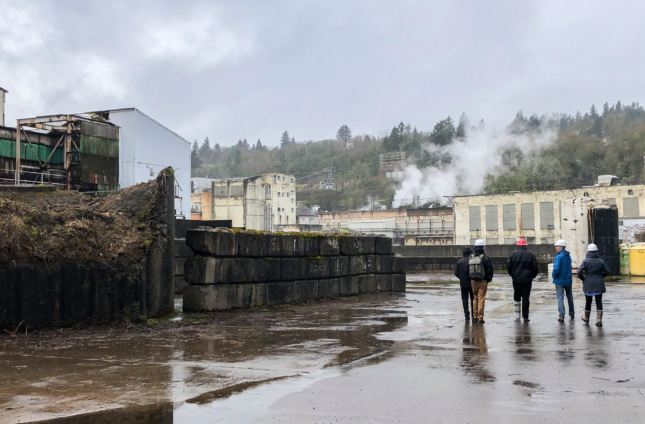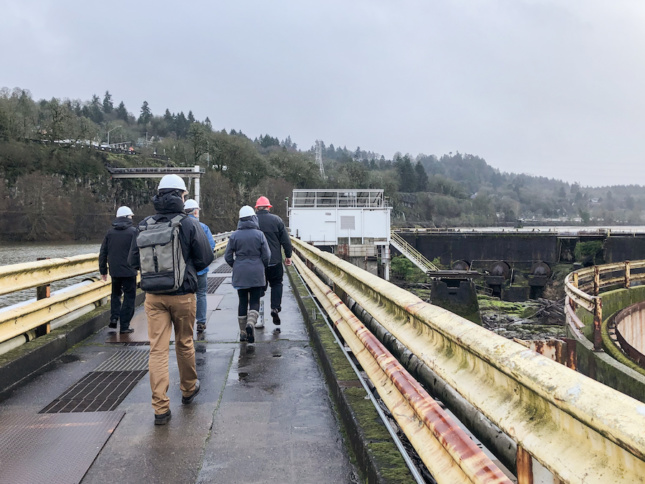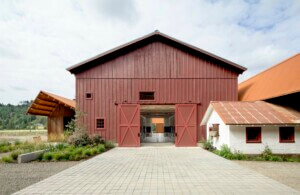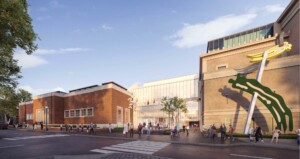The Willamette Falls Trust, the organization spearheading engagement, private fundraising, and programming efforts for the future Willamette Falls Riverwalk in Oregon City, Oregon, has partnered with nonprofit architecture firm MASS Design Group, whose U.S. offices include Boston, Poughkeepsie, and Santa Fe, to kick off a new and vital phase of engagement and outreach.
Per a statement announcing the news, the process will focus on gleaning—and then prioritizing—input and advice on design and programming aspects from five confederated tribes. This includes the Confederated Tribes of Grand Ronde, Confederated Tribes of Siletz Indians, Confederated Tribes of the Umatilla Indian Reservation, Confederated Tribes of Warm Springs, and Confederated Tribes and Bands of The Yakama Nation, along with members of the urban Native American population in the greater Portland metro region as a way to ensure that “the Riverwalk centers indigenous experiences and educates the greater Portland community on the Native stories of the region.”
“Not only will the Riverwalk be a special public space, it will also allow visitors to access the complex and difficult histories of Oregon City through curated storytelling and programming,” elaborated the Trust.
The ambitious project, first kicked off in 2011 following the closure of the then 100-year-old Blue Heron Mill, aims to breathe cultural and recreational life into a long-blighted and closed-off industrial area spanning 22 acres along the horseshoe-shaped Willamette Falls, the second largest waterfall in North America by volume. In 2014, the Willamette Falls Legacy Project, a collaborative partnership between several public agencies, was formed. The following year, an initial design and public engagement process kicked off with a design team led by Snøhetta, in collaboration with Portland-based landscape architecture firm Mayer/Reed and Toronto-based DIALOG.
In 2017, Phase One design concepts for the Riverwalk were revealed. Portland-headquartered integrated design and engineering firm OTAK was tapped to “bring the Riverwalk design to life” in 2019, the same year that the old Blue Heron Mill site was purchased by The Confederated Tribes of Grand Ronde for an undisclosed price. The tribes are currently leading extensive assessment and clean-up efforts at the site in an agreement with the Oregon Department of Environmental Quality. It’s expected that Phase One designs will be finalized later this year along with a construction timeline.

However, as Oregon Business reported in January of this year, work on a planned public walkway through the Blue Heron Mill site, which encompasses numerous decrepit industrial buildings, will be delayed until 2021 after the Confederated Tribes of Grand Ronde expressed concern that ongoing work at the site, which involves extensive renovation, demolition, and decontamination projects, would pose a public safety risk. The tribes have requested that, for now, the walkway be limited to the riverfront and not within the old mill site, as was originally planned. Before paper mills were established at the site in the early 1800s, the area along and around the falls had served as a bustling trading and fishing grounds for local tribes.
Project team members from the Sustainable Native Communities Lab at MASS are collaborating with the Trust, which was formed in 2016, on multi-tribal outreach, engagement, and programming together with the tribal communities with deep roots at the Falls. MASS’s engagement work will complement previous work completed by design teams and is iterative of the larger public outreach process and a means of ensuring that indigenous voices are featured front and center in the use, design, and programming of the future Riverwalk.

As the Trust explained in detail:
“Providing exemplary culturally-responsive experiences at Willamette Falls means ensuring that the stories told there reflect the full range of the Falls’ human and natural history. While multiple area organizations keep and convey the Falls’ pioneer and industrial stories, the voices of indigenous people are notably muted. Formed to serve as an intermediary among the numerous public and private entities with an interest in the Riverwalk project, the Trust has emerged as the natural leader of an effort to center indigenous voices from many tribal communities, in the planning processes of design, interpretation, programming and conservation for the Riverwalk and beyond.”
“We build our work on the fundamental belief that architecture is never neutral—it either hurts or heals,” added Joseph Kunkel, Design Director of the Sustainable Native Communities Design Lab at MASS. “The opportunity that exists at the Falls to engage collaboratively with multiple tribes is a just and much-needed healing gesture. We look forward to working with the Trust to make this ambitious vision for a sacred and restorative cultural and recreational space a reality.”
The Willamette Falls Riverwalk project operates as a partnership between Oregon City, Clackamas County, the Metro regional government, and the Willamette Falls Trust. As of August 2019, the price tag attached to this impressive riverfront revitalization project that revolves around four core values—historic and cultural interpretation, economic redevelopment, public access, and healthy habitat—was $35 million.
“Although the COVID-19 pandemic has required us to physically distance ourselves from one another, this challenging time is bringing into focus how important it is to bring people together,” said Andrew Mason, executive director of Willamette Falls Trust. “We are taking this bold step with MASS, local government, and tribal communities because we recognize this rare and unique opportunity to create healing for people and the environment.”











